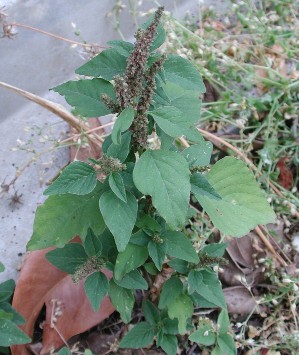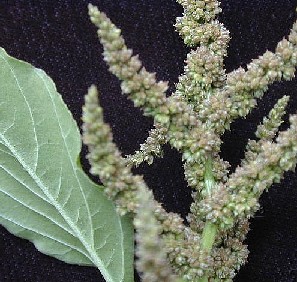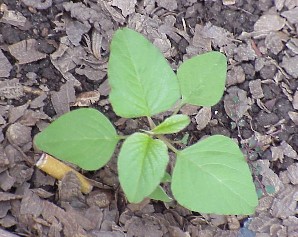Scientific name: Amaranthus viridus L.
Common name: Green amaranthFamily: AmaranthaceaeOrigin:Native of tropical America. Habit:Annual herb to 1 m tall, with erect habit. Habitat:It is a very common garden weed found. Also found in areas such as roadsides, parks, pastures and other disturbed sites. General description:Stems and leavesStems can be hairless (glabrous) or sparsely hairy. The leaves are alternately arranged, and entire, with petioles 7-70 mm long. Leaf blades are egg-shaped (ovate) to almost triangular (1.4-8.5 x 0.9-5.5 cm in size). The leaf tips vary, being blunt, pointed or rounded with a notch. The leaf base is either wedge shaped or cut off squarely. Flowers and fruitFlowers are small with 3 'petals' (perianth segments) about 1.5 mm in length. They are borne on branched inflorescences 5-10 cm long, and also in axillary clusters (which emanate from the bases of the upper leaves). These inflorescences can be green or have a pinkish or reddish-brown colour. Flowering may occur throughout the year. The fruit are 1.5-2 mm long and have a wrinkled surface. Seeds are round (1-1.5 mm in size), black-brown in colour and with a warty texture. Distinguishing characteristics:Annual herb with erect or ascending habit, growing to 1 m tall. Leaves are light green and the fruit are obviously wrinkled. Amaranthus spinosus (spiny amaranth) is similar to Amaranthus viridus (green amaranth), however it has prominent axillary spines and its leaves can have an obvious reddish or purplish tinge. Noxious status:Not noxious. Sources:Auld, B.A. and Medd, R.W. (1996). Weeds: an illustrated botanical guide to weeds of Australia. Inkata Press, Sydney. Kleinschmidt, H.E., Holland, A. and Simpson, P. (1996). Suburban Weeds. 3rd Edition. Department of Primary Industries, Brisbane. Stanley, T.E. and Ross, E.M. (1983-1989). Flora of South-eastern Queensland. Volume 1. Department of Primary Industries, Brisbane. |
Brisbane
St Lucia, QLD 4072
+61 7 3365 1111
© 2009 The University of Queensland




